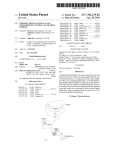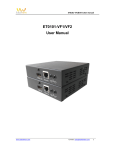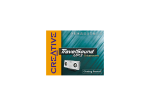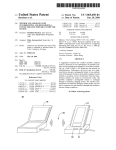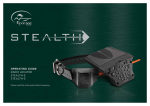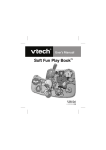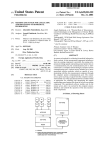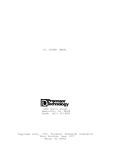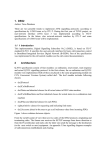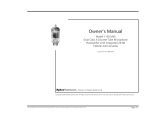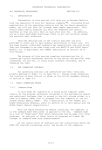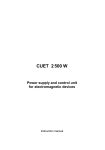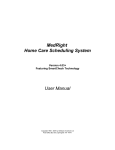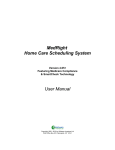Download Portable computer for dual, rotatable screens
Transcript
US 20080062625A1 (19) United States (12) Patent Application Publication (10) Pub. No.: US 2008/0062625 A1 Batio (54) (43) Pub. Date: PORTABLE COMPUTER FOR DUAL, ROTATABLE SCREENS (60) Provisional application No. 60/ 160,001, ?led on Oct. 18, 1999. (76) Inventor: Je?rey Batio, San Diego, CA (US) Correspondence Address: Publication Classi?cation (51) Int. Cl. Welsh & Katz, Ltd. G06F 1/16 Daniel M. Gur?nkel Mar. 13, 2008 (52) (2006.01) U.S. Cl. .......................................... .. 361/680; 361/681 22nd Floor 120 South Riverside Plaza Chicago, IL 60606 (US) 21 ( ) (22) A l. N .: pp Filed: 0 11/804 367 ’ May 18 2007 ’ Related U_s_ Application Data (57) ABSTRACT Aportable computer having a independently mounted screen sections, Whereby the screen sections may be used to pro vide a larger overall screen, to provide screens mirroring each other for presentation and display, for use by different users, and the like. The screen sections are foldable and (63) Continuation of application No, 09/690,799, ?led on Oct. 17, 2000, noW abandoned. collapsible into the main housing of the portable computer for storage and transport. atent Application Publication Mar. 13, 2008 Sheet 1 0f 9 FIG. 1C US 2008/0062625 A1 Patent Application Publication Mar. 13, 2008 Sheet 2 0f 9 US 2008/0062625 A1 FIG. 2A Patent Application Publication Mar. 13, 2008 Sheet 3 0f 9 FIG. 2C FIG. 2D US 2008/0062625 A1 Patent Application Publication Mar. 13, 2008 Sheet 4 0f 9 FIG. 3B FIG. 3C US 2008/0062625 A1 Patent Application Publication Mar. 13, 2008 Sheet 5 0f 9 FIG. 3D FIG. 3E FIG. 4A US 2008/0062625 A1 Patent Application Publication Mar. 13, 2008 Sheet 6 0f 9 FIG. 4B US 2008/0062625 A1 Patent Application Publication Mar. 13, 2008 Sheet 7 0f 9 US 2008/0062625 A1 Patent Application Publication Mar. 13, 2008 Sheet 8 0f 9 US 2008/0062625 A1 Patent Application Publication Mar. 13, 2008 Sheet 9 0f 9 FIG. 6D FIG. 6E US 2008/0062625 A1 Mar. 13, 2008 US 2008/0062625 A1 PORTABLE COMPUTER FOR DUAL, ROTATABLE SCREENS mounted horizontally), most of the on-screen document (a piece of paper is 8.5"><ll") is lost and the user is forced to “scroll” the document doWn to read the entire page of text. BACKGROUND OF THE INVENTION [0001] The present invention is a system of computing is based upon a proprietary design comprised of a hinged base unit and pivotally mounted dual independent displays that provide the foundation of the system. (The other folding units need to be incorporated into this language-also add the latest folding designs) The unique design alloWs the machine to be much more than the sum of its parts. Thanks to the invention, the unit is capable of providing all of the Working bene?ts of a full-sized desktop Workstation that collapses via folding into a portable form factor. The unit functions equally as Well in the unique dual (side by side) [0008] To remedy the landscape portion of this problem, many of today’s desktop-bound LCD monitors can pivot on a frame-mounted hinge to physically rotate the screen from the inef?cient landscape orientation to the far more useful and productive Portrait or vertical mode. Since most com puting Work requires document creation, and in most of the World a standard document is 8.5"><ll.0" (portrait) the portrait re-creation of the image onscreen saves the user considerable time and effort from not having to constantly reposition (scroll-doWn) the image onscreen to read a full page of text. portrait screen modes as it does in the more traditional [0009] landscape modes, though it is the unique case design/s that monitor screen provides, it is deemed a poor source for alloWs it to do all of this in a convenient and stylish self contained unit. betWeen them as compared to multiple individual displays [0002] Though Larger units can be made, the marketing that run the individual applications full-screen per monitor. Microsoft likely sees this as a fact since they have since direction of the design of the units also indicates that a comprises a minimum of tWo smaller variations on the theme shall be produced. The ?rst is knoWn as the Flip-Pad VectorTM a mid-siZed unit that travels in the same siZed package as a small notebook or sub-notebook, but opens to provide approximately 17" or so, display area and a full siZed keyboard. [0003] The StealthTM is the Flip-Pad that folds to travel in the siZe of a handheld PC, yet opens to give the user a full-siZed keyboard and a much larger screen (ll-l2") than is currently available in the handheld market. [0004] The NomadTM is the Company’s folding full-siZed keyboard and mobile expansion device that also can expand to be a mobile Wireless Internet broWser. The Nomad is comprised of the folding base unit Without the screens. The unit folds closed in the opposite Way to protect the keyboard halves. This enhanced mobile expansion device With a keyboard interface also interfaces With the full-?edged PC versions to alloW for multiple users and interaction. [0005] The Future of ComputingTM is here today. The Moreover, due to the inefficiencies that the single adding multiple WindoWs and dragging information designed internal operating system softWare support (driv ers, etc.), commencing With the release of WindoWs 98TM that alloWs for multiple (up to 9 displays) to run as one large contiguous on-screen desktop. While this is an advantage, there is currently no Way to bene?t simultaneously from the advantages of multiple displays and the advantages provided by portrait display mode, joined in a portable form of computing, until noW. This value is present Whether either of the displays rotates 360 degrees, 180 degrees or neither rotates at all. This is key to point out, because the primary bene?t of the dual displays is the increases gained in useable on-screen real estate, the travel bene?ts of tWo independent folding displays and the advantages in screen resolution When tWo displays resolutions are multiplied. [0010] The XentexTM Flip-PadTM Quad-FoldTM architec ture of the present invention provides a portable dual portrait screen solution to address all these issues, Whilst bringing about other additional and bene?cial advancements to the computer user. Advancements that are not currently knoWn in the market, as is described in detail beloW. revolutionary form factor provides for a host of additional advantages for the existing computing market and the emerging TeleComputingTM markets, as is described beloW: SUMMARY OF THE INVENTION Screen OvervieW Screen Applications [0006] The deluge of information that We receive daily and need to sift through in the digital World today is overWhelming to say the least. With the advent of Microsoft WindoWs 95/98, users can effectively multi-task by simply opening more than one program on-screen and simulta neously share data betWeen the programs. Such as the act of inserting a digital image into a text document, or for example, Microsoft Of?ce Suite users frequently create spreadsheet data in Microsoft Excel (charts and graphs) and then need to cut and paste that information into Microsoft Word in order to create complete documents. Due to the single screen nature of most PC setups, the user has to shrink each program WindoW doWn signi?cantly in order to high light and then share the information betWeen the program WindoWs. [0007] Additionally, since most computer setups feature one screen mounted in landscape (a rectangular vieWing area [0011] The Large version of the Flip-Pad system (code name: VoyagerTM) of the present invention has tWo built-in 14" or 15" Liquid Crystal Displays (LCD) mounted in portrait mode (side by side). There are approximately 3-4 mm betWeen each screen. On screen the tWo LCDs act as one large display area, and are equivalent to a contiguous 23" LCD. For reference there are currently no 23"-25" LCDs available in the World, since a single 23" display is too dif?cult to build and manufacture at a marketable cost. This is because LCDs are constructed of tWo glass substrates With the electronics sandWiched betWeen them. As such, due to the inherent physical properties of glass, they are too fragile to travel With and also frequently suffer from ever-larger unacceptable levels of dead pixels. They are also obviously not portable due to the siZe and ?exing loads suffered by one large panel, etc. For example, The bene?t of the tWo l4"-l5" (or larger or smaller) LCDs mounted side-by-side, act as a full 23"-25" LCD When the tWo LCDs are operating in the Mar. 13, 2008 US 2008/0062625 A1 contiguous mode of operation. The resolution of the tWo displays together is noW l,024><l536 pixels. (Note: the current resolution limitations each LCD in landscape mode is l,024><768 and When these are increased by the manu facturers design, the resolution still alWays multiplies by tWo on the Flip-Pad design.). [0012] This alloWs a user to have a simulated/real 23" LCD that under current constraints had not been possible, before the Flip-Pad design. The bene?ts and increase in ef?ciency and productivity escalates signi?cantly to the end user. [0013] The unique feature of the basic system design is the ability to use the tWo internal displays in the system in several different Ways. This is a user experience that is [0021] FIGS. 3A-3D shoW a third embodiment of the invention With a double screen monitor pivoted together along opposite horiZontal edges to form a Z-form; [0022] FIGS. 4A-4D shoW a fourth embodiment of the invention shoWing a portable computer that may be used as a stand for a desk top With removable keyboard; [0023] FIGS. 5A-5C shoW a ?fth embodiment of the invention With a double screen monitor pivoted together along opposite horiZontal edges Which may be used for a presentation; [0024] different positions. totally neW to the industry. The folloWing methods of usage DETAILED DESCRIPTION OF THE INVENTION are: [0014] a. Virtual Desktop: In this mode, the end user uses the screen as a huge 23" LCD equivalent. This is de?ned as using the tWo dual displays to represent the data onscreen much like one large monitor. The only difference in usage betWeen a single large display and the usage in this mode is the very small physical separation betWeen the tWo displays. [0015] b. Mirror Mode: Is de?ned as mirroring the image on one screen to the other. [0016] FIGS. 6A-6E shoW a sixth embodiment of the invention shoWing a screen that may assume a number of This is de?ned as the tWo displays exactly match What is on one screen With the other. The advantage of this is When you physically rotate one of the screens l80-degrees from the other, you can then present your Work to others sitting opposite you. [0017] c. Independent Display Mode: This is de?ned as When the user operates the tWo displays as totally separate and independent monitors. One usage is tWo people using the system via an additional keyboard and mouse plugged into the system, and then actually doing their oWn Work simultaneously on the single system. This is also very bene?cial When tied to the fact that for the ?rst time in a self contained pre-con?gured por table, the user can run multiple operating systems Detailed Description of Screen Uses [0025] Portable Dual Displays in Portrait Mode: [0026] Due to the multiple levels of ef?ciencies of data management and manipulation provided by standard dual display technology, it is currently Well knoWn and practiced throughout the industry. What is currently unavailable and unknoWn, is dual displays functioning seamlessly in dual portrait mode in a portable self contained pre-con?gured setup. Portrait is de?ned as rotating the traditionally land scape (horizontally mounted) display into the vertical ori entation. Currently no knoWn product offers dual displays recogniZed as one large display in portrait mode. The Flip-PadTM provides the screen real estate solution in a portable form factor, Whilst also utiliZing the screen resolu tion far better than currently available LCD technology as is described beloW. Furthermore, there is no knoWn dual display technology available in a portable form factor, Whether portrait or landscape. [0027] Portrait Presentations: laptop With either WindoWs or LINUX. To run one or [0028] Due to the additional screen real estate provided by the portrait orientation of the screens, the ability to present computer generated information and/or slides is enhanced beyond traditional landscape orientated slides. Since most the either on the same machine requires the User to reboot the machine. In the case of the dual screen text must reference the standard 8.5"><ll.0" portrait orien tation of a standard page of text, the presenter gains signi? simultaneously. For instance, currently Users can run a Flip-Pad and the advantage of the Dual Boot system cant room for more room for text per slide thus reducing the described on page 34, of this application, the User can number of slides required per presentation, and also pro run both Operating Systems simultaneously for the ?rst vides for more room for pictures and illustrations along With time. This is of substantial bene?t to Users running applications in both environments and is also useful for the required text. side-by-side comparisons of the O/S’s in question [0029] Resolution Enhancements: [0030] BRIEF DESCRIPTION OF THE DRAWINGS [0018] The invention Will be more readily understood With reference to the accompanying draWings, Wherein: [0019] FIGS. 1A-1D shoW the ?rst embodiment of the invention With a hand-held portable computer of the present invention having a double touch screen pivoted together along opposite horiZontal edges; [0020] FIGS. 2A-2E shoW a second embodiment of the invention With a double screen monitor pivoted together along opposite vertical edges; Screen resolution cannot seem to be high enough for many computer-using professionals. The higher the resolution (number of vieWable pixels) the clearer the onscreen image appears While also providing more useable onscreen image space on the same siZe panel. This is easy to demonstrate by simply changing the resolution in the moni tor settings properties of any PC up or doWn to illustrate the point. [0031] As stated, the higher the resolution, the more desirable and useful the monitor solution. Current LCD technology is limited in its ability to reproduce image resolution-much beyond XGA resolution of l,024><768 pix Mar. 13, 2008 US 2008/0062625 A1 els. This has hampered the adoption of LCD technology by the Workstation users, Whose Work typically requires the portable camcorders today, are there so that the operator can place the camcorder on a tri-pod and then ?ip the screen over higher resolutions. to spot themselves in the shot. Obviously the larger the [0032] The Flip-Pad resolution is greatly increased as a direct result of taking the standard displays and rotating them into portrait, and utiliZing the tWo smaller displays as one large Workspace. By doing this, the unit achieves an on-screen vieWing resolution superior to the currently avail able LCD panels on the market. Traditional single display mounted in the landscape mode can currently achieve reso lutions of 1,024 horiZontal vieWable pixels x768 vertical vieWable pixels, by rotating both displays to portrait (the vertical is noW 1,024) and then combining their existing (768) resolutions, the displays provide a combined vieWable resolution of l,536><l,024 a resolution that is currently unachievable With LCD panels today. [0033] Multiple (Up to Four) External Display Support: [0034] Thanks to the unit’s inherent ability to display and rotate, the onscreen images from the native landscape mode of WindoWs and WindoWs based applications in the systems hardWare circuitry via the dual dedicated video chips (or custom designed integrated circuit chip that combines the functionality of the tWo or more separate chips into one single chip), the unit can additionally run tWo more external displays for a total of four. This adding to the original tWo onboard displays, that combined functions as one contigu ous desktop display. This ability to present ever more screen real estate to the user is of signi?cant and novel bene?t With universal appeal. For example, securities traders never seem to have enough screen real estate to run their multiple applications and they certainly do not have a portable option-noW they do. screen the easier it is to see and line up the shot. [0040] The next advantage under this system is that a user can be typing the text to be spoken on the unit’s keyboard, and then is reproduced on the rotated display so that the person speaking the text in the ?lmed shot and can easily see themselves and read the text onscreen. Once completed, the footage can be easily edited and assembled into complete footage. This is more ef?cient When the user installs the video editing key-slabs in place of the removable standard alphanumeric keyboards (as is described further in the keyboard section of this document). [0041] Health Bene?ts and Desk Space Savings: [0042] Current CRT’s monitors emit electromagnetic radiation from the front of the monitor toWards the computer user. Conversely, LCD monitors do not. LCD monitors are far healthier for the user to operate and also cause far less eye fatigue since they are not prone to the onscreen image ?ickering of CRT technology. Currently no Workstation user can bene?t from the advantages of a Mobile WorkstationTM and gain the safety and health bene?ts provided by LCD technology due to the resolution limitations. The Xentex Flip-Pad solves this dilemma. [0043] Furthermore, LCD panels are far smaller and lighter and require far less electricity to operate and are thus more ecologically sound in design. The CRT monitor, pro vides the resolution solution but at the expense of portability, safety, ecology and desk space. The Flip-Pad Quad-foldTM architecture remedies this for all. [0035] The Flip-Pad’s dedicated video architecture has the ability to support tWo additional external monitors (portrait Screen Usage and or landscape) for a total of four displays as one large Stationary or Rotation for Added Functionality desktop (as described beloW). Under this con?guration, the [0044] The system is designed to function as the ?rst unit provides maximal resolution of l,024><3,l52. This is a resolution that is unheard of in either the desktop CRT or LCD realm and Wont be available for many years. This is portable dual portrait display full featured computer. That due in part to the unique physical design of the system and majority of the functionality described herein. HoWever its ability to minimize to almost non-existent levels, the gap When on or more of the displays rotate through a range of need not have any of the displays rotate to provide the betWeen the displays. 0-180 minimum, an additional level of unique and novel [0036] Video Conferencing and White-Boarding: functionality bene?ting the operator of the system is imparted. In this regard, The system is con?gured to alloW [0037] multiple levels of screen usage via the rotating hinge/ s. The primary incarnations are: The ability to have tWo displays adds further value to the end user that is seeking to use the system as a video-conferencing system. This system Will put the video image of the remote communicator full-screen, While the document that is being collaborated on, is full-screen on the other display so that each user may remotely Work on the document. [0038] Mobile Video Camera Interface With Teleprompter & Editing Functions: [0039] The unit Will be able to further enhanced via the ability to plug a camcorder into the back of the unit and alloW for easy video editing. In this incarnation, the user can easily edit full-screen the incoming source into the edited source full-screen. Furthermore, the user can rotate the display and stand at the back of the unit and vieW themselves in the shot full-screen. This is of great advantage to video users, since the reason that the LCD panels common on most [0045] 1). One user rotates one of the displays 180 degrees to present the screen area to others sitting opposite the primary user Who is controlling the device. [0046] 2). TWo users to each using an individual screen at the same time. In this mode tWo users could be either are using the system With each both displays facing them While facing each other across the base of the unit and each having a separate keyboard and pointing device and or using the onscreen stylus capability. In other Words the tWo users are interacting on one system While on opposite sides of the system and facing each other. This is accomplished by setting the system up in the standard operational mode With both displays facing the primary user, after Which, one of the displays is rotated to face the rear of the unit. At Which point the second User sits opposing to the ?rst user and then plugs Mar. 13, 2008 US 2008/0062625 A1 in the necessary input devices via the ports on the back of the machine. Thus allowing for independent or linked usage of the machine. [0047] 3). In this con?guration, The screens are both rotated a minimum of l80-degrees for rear facing full-screen presentation. They then can be folded back doWn upon the base. This alloWs several other con?gu rations: [0048] a). As one big tablet, this is characterized by having both displays rotated and then folded ?at upon the base. [0049] b). The base unit can then be folded in half at the base hinge to provide for dual opposing screens in landscape orientation. [0050] Rotatable Display/s: [0051] Today the acronym PC stands for Personal Com puter. Translation: a single screen computer limits the inabil ity for tWo users to Work together, interact, or present data to each other ef?ciently on the one traditional single screen PC. Thus rendering it more of an impersonal PC. [0052] US. Pat. No. 5,949,643 calls for one of the dis plays to be rotatable 360-degrees for convenient displaying of the on-screen image to Whomever is Within the vieWing area creating the ?rst iPCTM or Inter-Personal ComputerTM. To achieve the other uses of the unit, only one display [0057] The current existing desktop PC solutions do not support individual sound. [0058] The Flip-Pad of the present invention brings the advantages and value of multiple users (up to four With the addition of tWo separate monitors as is described beloW) on one primary base unit. This is accomplished via the built-in dual displays that rotate (either one or both). This Way the unit provides for the existence of a portable tWo-user plat form for head-to-head ComputingTM that alloWs for real time collaboration and independent computing. Further more, since the unit’s individual displays are in close proximity to the base unit, and the base mounted speakers can be easily heard. Additional speakers can be mounted in the individual display halves, so that sound can ?nally be reproduced per user. In fact, the sound signals can be split per side per user so that simultaneous sound can be repro duced. The unit can also feature dual audio input and output jacks for separate headphone and microphone usage. [0059] Multiple Processors Availability Due to the Ther mal Solution: [0060] This concept ties into multi-user mode of having the system be capable of using either one processor or up to tWo processors (CPUs) that are designed into the actual physical system. This provides unlimited processing speed per user. And is possible due to the combination of the additional case area and the ensuing thermal solution as is described beloW. Under this con?guration, one user could be can/ should be rotated, and only l80-degrees. This alloWs for several neW and proprietary applications: using one processor and another user using the other pro cessor offering the exact no compromise computing poWer of tWo stand-alone PCs. This has more advantages instead of [0053] having tWo users sharing one processor. TWo Users on One PC: [0054] There is currently knoWn add-in PC video card technology that alloWs current PC’s to utiliZe the copious amounts of processing poWer and alloW tWo or more users to share on PC and CPU (Central Processing Unit), and modem/Intemet connection via this sharing or networking solution. The knoWn technology is provided via a plug-in video card that has tWo video chips and a port on the back for an included signal splitting box. This card is installed in the desktop (not mobile) PC and then the splitter box is plugged into the external port on the outside face of the card. The splitter box provides additional standard ports for the traditionally required additional monitor, keyboard and pointing device (mouse, track ball, etc.). Upon successful installation, the users can boot up the PC and can then log on as individual users and even share an internet/modem connection to surf the Web simultaneously or run applica tions independently. Per screen, users can even set up individual preferences per screen like Wallpaper, icon siZe and style, etc., just like it truly Were tWo separate and independent PC units. The value is that one PC can noW service tWo or more users simultaneously (up to four With the right hardWare con?guration). The value propositions are obvious, as one household or Workgroup can save the money of separate additional PCs and printers, etc. In fact, you can collaborate together as if it Were a mini-netWorked environment. The only major draWbacks to this solution are: [0055] l) The cost of having to buy the additional separate hardWare: monitor, keyboard, mouse, etc. [0056] 2) The con?guration is certainly not a portable solution. [0061] Dual Processor Mobile Workstation: [0062] The dual processors can also be linked together so that the unit becomes the ?rst dual-processing mobile Work station. This is unheard of in the mobile World. [0063] Mechanical Design Simulates a Virtual Display: [0064] As mentioned, the dual display system side by side is signi?cant and unique unto itself. But the ability to expand the usable screen area to up to 4 displays that are arranged on either side of the machine that alloWs for an amaZing resolution of l,024><3l52 is further enhanced by the mechanical design of the system in that it provides for a very minimal gap betWeen the individual panels. This is far superior to the current usability that users must endure of standard self-contained monitors combined under traditional multi-screen applications. This is because the frame area around independent desktop monitors is much larger than the 3-4 mm gap betWeen the Flip-Pad displays. In theory, the design could be expanded up to multiple (9 or more) additional displays if one chooses. Once again, the key is the minimal gap distance betWeen the displays as compared to standard desktop displays. The Flip-Pad is the only Way to get a true multi-monitor solution that more closely resembles one large contiguous vieWing area. As a result of the unique applications that noW become available like never before, the user experience expands immensely and productivity goes Way up. 0065 1 - s creenTMA ccesso ry I Fl'p [0066] An accessory unit Will have a proprietary design for an interlocking hinged clamshell design that conve Mar. 13, 2008 US 2008/0062625 A1 niently houses tWo additional LCD screen panels for use With the system. The case Will hinge in the center like a book, and upon opening, the dual portrait displays are presented to the user for vieWing. The unit can be connected to the base unit intact, or the unit can be separated at the hinged halves for presentation on the desktop surface. When separated, the individual displays are then placed on either side of the main Flip-Pad units existing displays. The cases Will be styliZed to match the external housing of the base unit and Will also have fold doWn multi-adjustable hinged feet for leveling and equalizing With the screens mounted on the base unit. [0067] Flip-BookTM DoWnloadable E-Book: [0068] The dual clamshell designed auxiliary screen Screen Rotation/ s in Detail [0074] Tablet ModeiRotation of Only 180 Degrees: [0075] The screen may then be folded back upon the case half and then When the base of the unit is then fully closed in order to provide an electronic tablet surface (utiliZing current touch-screen LCD technology), upon Which the user may Write notes via a digital ink softWare program by using the onboard stylus pen, to control the machine When it is in the folloWing landscape/ DVD mode. Also, this limited range of rotation (l80-degrees) assists in the hinges ability to support the Weight of the screen so that it does not slip doWn When the unit is elevated into DVD mode. [0076] Landscape/DVD ModeTM: tional proprietary feature, and that the additional elec [0077] The unit When folded back upon itself, the user may then release the base sections from the locked position and position the units screen at a comfortable vieWing angle tronic storage and circuitry built into the screen cases, using the base hinge and the included stiffening clutch, to so that text may be doWnloaded into the screens and position the unit so that it is serving to display the one screen in the traditional landscape mode. The unit Will feature a “hot button” Which is a single function dedicated button system described above also may contain one addi edited via touch sensitive screens and a form of stylus. This is extremely useful alone or as part of the entire system as a lightWeight full-siZe electronic dual screen textbook (or NextBookTM or Flex-BookTM). The ability located on the device, to toggle the image from its native portrait vieW to the required landscape or DVD vieWing to doWnload user created documents or notes created mode. via the keyboard or With the stylus and then to carry only the screen tablets provides a very lightWeight ing areas that are small in Work area such as in an airplane enhancement to the Flip-Pad system. The text editing done With the assistance of the touch sensitive screens, the data is then stored in a form of electronic onboard storage and then is available for electronic doWnload to the base unit via either the infrared capability or through a cable connection or both. [0069] Custom Portrait Con?gured LCD Panels: [0070] The fact that no company has designed a full-time [0078] This orientation is of additional advantage in vieW seatback tray arrangement. For reference, due to the shape of a traditional portable computer Where the screen lifts up from the base unit, the user often needs to slant the screen far past the 90-degree full vertical position for ease of vieWing. This is in direct con?ict With the seatback mounted airline tray, since the seatback also reclines toWards the screen that is ?ipped backWards. Often the screen and the seatback collide and the screen either breaks, or the user needs to move their machine. This is very cumbersome and dif?cult. portrait LCD is something that is of great value to Xentex. The design is for a reorientation of the standard roW and column drivers of regular landscape LCD monitors into a portrait mode orientation is neW and unique and of Xentex design. (Details to folloW). [0071] Four Users on One PC: [0072] The Xentex design has the ability to extend the tWo dual displays in the system to have additionally 2 additional remote screens, Which could reside anyWhere in relation to the system. These tWo additional displays When attached to the system can be vieWed as either mirror mode (duplicate) of one of the displays in the attached system, or could have all four displays in the system as mirror mode. In addition, all four total screens can each be separate as unique indi vidual screens running off the system. The unique point about the external screens is they can be in landscape or in portrait mode. [0079] [0080] The unit can be con?gured to provide for both displays to rotate l80-degrees and then be folded back upon itself to provide for a easy to read and Write upon digital tablet and also as a full-sized dual screen digital e-book or E-MagaZineTM to alloW users to doWnload current books and periodicals and read it onscreen full siZed. [0081] Dual Displays in Landscape Mode: [0082] Serial Bus) ports, the ability to add the necessary keyboards and pointing devices, including the folding keyboard expan The unit can then be unclasped at the base and have both the left and right display’s onscreen images toggled to landscape. UtiliZing the rubber strip that Wraps around the unit as feet to stop the “tented” unit from sliding on the desk, the unit can then function as a dual-display in landscape mode for head-to-head gaming, kiosk or other such land scape oriented applications. [0083] [0073] This also alloWs up to four users to log on and have their oWn vieWing sources per user. Using the units addi tional base unit case area to add additional USB (Universal Dual 180 and/or 360-Degree Rotation of Both Displays: The unit Will also function as a dedicated single function DVD or visual CD or CD/DVD based single or multiple (up to four) screen game display platform as is described beloW. [0084] DVD/Gaming Mode: sion devices mentioned in the ?rst application, to provide the [0085] input means necessary. Game playing mode, can function as a stand-alone device The unit When functioning in the dedicated DVD/ Mar. 13, 2008 US 2008/0062625 A1 that plays: either DVD movies, video games or music CDs The current crop of dedicated gaming consoles such as CD Without the need to run under Microsoft Windows or other based platforms made by Sony Corp. as the Playstation, and such Operating System (0/ S). This is useful because the unit Sega Corp. as the Dreamcast system, or Nintendo Corp, as a cartridge based system knoWn as the N64, all suffer ?ve need not be consuming precious battery resources to run the operating system and can dedicate all of the available precious battery-poWer resources to running the media of choice. This is achieved by using a dedicated circuit board that imitates the DVD/CD/video gaming hardWare circuitry and is booted into the proper mode based on one of the folloWing occurrences: 1) if the unit recogniZes the unit is folded into the single or dual landscape mode via a propri etary sWitch, 2) if the onboard gaming device-bay drive is loaded, or the user selects the proper boot-mode from the proprietary BIOS selection. [0086] Dual DVD Mode: [0087] Thanks to the dual screen nature and dual expan sion bay (more info to folloW) ability of the unit, tWo users can vieW tWo separate DVD movies or media per screen using tWo accessory DVD drives. This ability to interact as described beloW in the gaming device-bay section, and also to be entertained by movies tWo at a time is truly unprec edented in the World of computing and most certainly in the realm of portable computers. This mode is available under either dual-portrait vieWing (side by side), or under dual landscape (both display rotated l80-degrees and then folded back doWn upon the base of the unit). [0088] 3-D VieWing: [0089] The unit can reproduce three-dimensional images knoWn draWbacks as is described beloW: The Current Problems [0094] l) The units are not considered to be portable and self-contained in their entirety (no screens to vieW the action) [0095] 2) The units currently only support one single monitor as the vieWing source shared among the on screen participants, meaning that the image is parti tioned off in the softWare, equally per user on a single screen. This causes much on-screen confusion to the players. [0096] 3) The primary vieWing sources (standard TV sets) currently cannot support the high enough resolu tions that these hi-poWered games can display, thus the image on-screen does not live up to the programming efforts and capability of the gaming platforms hard Ware. [0097] 4) Currently, the only Way to add more players that can use their oWn private screen, is to link separate gaming systems together via cables. The Flip-Pad unit solves these problems by design. [0098] 5) Most platforms alloW for up to 4 players to image must be photographed from slightly different angles interact onscreen in many popular games, Which only compounds the screen division problem, Whereas the single physical screen is divided in the software to provide for four smaller individual WindoWs. This can (usually in single colors) and almost alWays as a still image. get very confusing. for the user like no electronic product ever invented. What is knoWn, is that to effectively reproduce a 3-D image, the The user then dons a pair of special glasses that serve to combine the colors and the image in order to fool the eyes and the mind into seeing an object in the third dimension. This technique Was pioneered in the 1800’s With a device called a stereoscope. The stereoscope took tWo separate photographs of the same scene or object and mounted them side-by-side on a rack. When the user held up a special set [0099] 6) The existing units require ever-larger amounts of information to be part of the gaming experience. For example, the player has maps, data ?les, inventories of collected items, etc. to consider in the gaming experi ence. This means that the interaction of the game is interrupted every time the user exits the action of lenses to their eyes, the combination of the differing sequence of the game to access this information. Thus angles and shadoWs of the photo images and the reorienting rendering a sequence unrealistic in that the opponent is nature of the lenses, the image appears to be in 3-D. forced to Wait until the screen action is resumed. [0090] The unique side-by-side nature of the Flip-Pad alloWs the user to easily enjoy 3-D vieWing. Xentex is creating a proprietary system to enable this that consists of 1). Unique 3-D softWare and/or a softWare compiler that converts images (still or in f‘ull-motion video) into the proper [0100] 7) The heat generated by the processors and hardWare necessary to run the current crop of high speed video game consoles, is overWhelming to, and thus currently precludes the design of a portable gam ing system split angled image necessary to recreate the 3-D effect, 2). The Flip-Pad Solutions Special lightWeight and stylish vieWing glasses necessary to complete the effect. [0091] This system Will be a lightWeight and comfortable Way to vieW 3-D on a PC like never before. This Will further enhance the gaming environment as is described beloW. [0092] Gaming Device-Bay: [0093] [0101] 1) Due to its Unique Quad-FoldTM design, the unit is considered highly portable, and it features tWo adjustable displays. [0102] 2) UtiliZing the dual displays Whether rotated or not, or in the native portrait or in the folded dual landscape incarnation, (though rotation is favored for The Xentex Flip-Pad has the ability to house the secretive head-to-head applications), electronic ver necessary gaming hardWare to recreate the video console game experience in a mobile platform. This hardWare can be sions of classic games like Scrabble, Poker, Battleship, Racing games, or any adventure that requires secrecy housed either in the second case half or as a device that per user become all the more enjoyable When each user slides into either one of the dual 5%" expansion bays in the case. The advantages of this approach are outlined beloW. of interaction. Furthermore, in tWo-player cooperation is treated to their oWn display for ease and enjoyment Mar. 13, 2008 US 2008/0062625 A1 games, if one user tries to go ahead of their on-screen partner, the faster user is forced to Wait, simply because one display cannot display tWo individually rendered environments individually for each user. The unique gaming environment provide by the tWo displays rem edies this for the ?rst time in a self-contained gaming (portable) system, [0103] 3) The unit features the highest resolution LCD screen knoWn to the PC market and as such is the ?rst portable self-contained gaming entertainment system that can display the high-resolution imagery made possible by today and tomorroWs future technologies. [0104] 4) The Flip-Pad unit can alloW for tWo-players or computer users to interact simultaneously or in entirely separate environments based on their needs and is not restricted by the current crop of technology. In other Words, the unit itself contains the processing and video poWer to render to individual on-screen images and then the dual displays can function as individual vieW ing sources Without the need for tWo or more separate video input sources (in the case of tWo separate linked units, and tWo separate displays). The unit can also seamlessly support up to tWo more portrait or landscape displays, as is described beloW: [0105] 5) Thanks to the unique nature of the Flip-Pads Quad-VieWTM, four monitor support solution, each of (typically 953,000-955,000 or more), 2) or a plug-in LCD panel that is then laid upon an inexpensive standard lighted overhead projector, 3) or a custom laptop that alloWs the back panel of the otherWise traditional notebook screen to be removed, and then the entire unit is laid With the uncovered rear of the otherWise traditional display to be supported on the overhead projector (as describe in example 2 above), and the laptop units built-in LCD functions as the LCD panel for projection. In any of these examples, they are very expen sive and cumbersome to implement When compared to the elegant Human Solutions by DesignTM that the Flip-Pad system provides. [0110] In de?nition, the unit can detach either the left or right display from the base unit via a proprietary hinge/ connector apparatus. The signal is then sent to the detached screen via a connector-equipped custom cable, or via the infrared signals generated by one or both of the tWo onboard infrared (I/R) WindoWs on the base unit. It is at this point, that the user then removes the back panel housing (including the re?ective surface that serves to project the image for Ward) of the screen in question. Thus providing the equiva lent of an onboard LCD panel for projection purposes, that can then be laid upon the overhead projector for a simple solution to the presenting problem. The advantage to the presenter is that they still have one of the active screens docked to the main unit for their speaker’s notes or other information that they Wish to present. As is described in the the four individual gamers or computer users can play Gaming Device Bay Section, #6, above, the user bene?ts via their oWn private monitor. even When a projector or other video source is plugged into [0106] 6) Due to the ?exibility that the multiple monitor the existing unit and used simultaneously in conjunction solution that the Flip-Pad Quad-Fold design permits, With the primary displays of the unit. This alloWs for a the User can plug the unit into a larger vieWing area, them in traditional presentation style, thus properly address ing the audience and having the bene?t of the dual displays Such as a big-screen TV set and use it to vieW the onscreen action continuously, While the primary dis plays of the unit function as the “Heads-up” informa tion displays simultaneously. This is unprecedented in gaming and any also is useful in presentations and such as is described beloW: [0107] 7) The Thermal Solution as described in the Thermal Solution Provides Multiple Upgrades and Layouts Section, page 31, the units inherent thermal design Works With the laWs of thermal dynamics to dissipate the heat far in a manner superior and unique by comparison to the current design of portable elec tronics. This alloWs for a solution set that provides the basis for the ?rst truly portable gaming system that sacri?ces nothing in terms of performance in compari son to the stationary models. [0108] Detachable Displays: [0109] In a separate incarnation of the design, gone or both of the unit’s displays can also be are detachable for a multitude of reasons. It has already been mentioned, that the rotation of one of the displays is most useful for interaction and presentation capabilities, though for presenting to large groups in an auditorium for example, the ?eld of vieWing is someWhat limited based on the screen siZe of one display. Though the Flip-Pad is far superior to existing portable presentations on a laptop, sometimes a presenter needs to project a very large image for group to easily vieW from a distance such as in an auditorium. Currently there are only a feW solutions for presenting computer-generated images to others. 1) A plug-in projector, Which is a very expensive presenter to have the presentation on a larger screen behind With Which the user can have one screen reserved for the speaking notes and the other to shoW the slide being pre sented behind them for ease of reference. [0111] Detachable Displays-2/Dual Notepads [0112] The detachable display/ s are also useful When the user Wants to use one or both of the displays as easy to manage electronic tablets. In this scenario, the user/s can each detach a lightWeight screen and connect the cables or use the built-in infrared capabilities to send the signals and use the tablets freely to enter text and take notes, aWay from the base unit. In this case, the unit is beginning to serve as a storable ?le server to the tWo independent Writing tablets. [0113] For example, for convenience or When user space is limited, such as in an airplane, the unit could have either one or both of the displays detached from the base unit, and then have the cables connected betWeen the screen/ s and the unit, While the base unit is stored in a travel bag, under the seat of the aircraft. The signals could also be relayed back and forth betWeen the screen/s and the base unit, via the infrared or otherWise Wireless signal. In this Way, one or tWo users (traveling companions) can either Work or play together via the tablet user con?guration. [0114] The unit Will also feature detachable screen sup ports that alloW the user to attach the clamps of the screen support to any side of the screen for either landscape or portrait vieWing on a ?at surface. This is so that the user need not hold the screen to vieW it. Once it is clamped ?rmly to the screen, the unit’s ?ip-down, adjustable foot supports Mar. 13, 2008 US 2008/0062625 Al the screen on a ?at surface. The foot is hinged to ?ip doWn, and also offers a range of motion to angle the screen to a comfortable angle. [0115] Custom Reel Monitor Cables [0116] The Flip-Pad requires that the signals be sent to the detached screens in order to recreate the imagery and handle any input/output signals. The unit Will alloW for the trans mission of the signal via a Wireless medium such as infrared (UK). It Will also alloW the unit to send the video signals via a connected cable that runs from the base unit connection to the screen-mounted connection. [0117] To facilitate the portability and convenience of this fact, the design calls for a custom (proprietary) design of cable that has a quick-coupling on either end to facilitate ease of connection, and a housing With a reel mechanism inside that alloWs the cables to be extended to the total [0124] Comparative WindoWs and Shopping: [0125] Shopping and auction sites via the Internet have increased exponentially in the years since 1996 When the net Went primetime. The ability to vieW images of products and read their individual speci?cations While comparing prices amongst vendors virtually at Will, has forever altered the Way We purchase items and “WindoW” shop. Yet one must still contrast and compare at least tWo competing products or prices, and levels of service, etc. to be sure of getting the best value for their money. The most effective Way of doing this is a side-by-side comparison. This Xentex application Will ef?ciently marry search engine technology With multi screen technology to produce a revolutionary Way to shop smartly, With far better informed and savvy customers as the result. [0126] The softWare Will alloW for searches in the com parative mode that Will produce mirrored broWsing WindoWs on each screen. What is currently knoWn is that the user can length for use and then retracted back into the housing for simply bring up separate broWser WindoWs and toggle stoWage and ease of travel. betWeen WindoWs to compare or on a desktop system using [0118] Proprietary Dual Screen Usage Applications: multiple monitors one could simply leave the WindoWs up and compare. What is unique to the Xentex WindoW Shop perTM custom application is that it is one large broWser [0119] There are currently many uses for dual screen WindoW that is reproduced on the individual screens as applications, graphic design, video editing, computer aided these are Well knoWn and established areas of use, Xentex separate WindoW PanesTM that have linked search engine capability. Simply put, the user can input a speci?c product or a category and then re?ne the search by setting price, shipping, service, siZe, Weight, etc. as the search parameters, has designed several proprietary applications for use With and easily compare products and services side-by-side, the system as described beloW and also more in detail in a instantly. The softWare also has the ability to narroW the design and manufacturing, CAD/CAM, softWare and Web site programming, ?nancial trading, gaming, etc. Though separate patent application: search once satis?ed and to easily seek out features on the presented pages that are individually entered into the re?ned Internet Software Applications [0120] The Internet has become very pervasive and has signi?cantly exaggerated the amount of time that people spend at their computers. In fact the Internet has revolution search engine [0127] Training Module: [0128] Thanks to the units dual screen nature, the machine can function as a mobile training platform. iZed the Way We Work, play, and learn. True as this may be, [0129] The problem With softWare today, is that by the the Internet broWsing experience is far from perfect. Thanks experience. time you get familiar With the program, the softWare devel opers have come out With the next generation of softWare, thus the learning curve usually out accelerates the average user. Additionally, the softWare is very complex, and the [0121] BackWard/ForWard Button Screen Management included user manuals are usually dif?cult to understand, so the user usually buys an aftermarket user manual such as the to the multi-screen nature of the Flip-Pad system, many neW and useful applications can be designed to enhance the Plug-InTM: IDG Books “ . . . For Dummies,” series. This leaves the user [0122] The ?rst is the Backward/Forward Button Screen Management Application. Research shoWs that the “back With the dilemma of alWays needing to purchase expensive manuals that quickly become obsolete, and also they obvi and forWard” buttons are the most frequently used buttons in broWsing. This is so that When you Want or need to vieW the traveling. This often leaves the user at a distinct disadvan previous Web pages, you tap either the back or forWard button and the broWser WindoW reproduces the former page/s. This can be very frustrating on a single screen landscape computer, since the page you left is likely still of ously cannot carry all of them With for reference When tage. The Flip-Pad system solves this by using the unique capabilities of the machines dual screens to provide for a mobile training system. By using the second screen to mirror the softWare program that is loaded full-screen on the interest to you, yet you simply cannot vieW tWo full pages primary monitor, the user can then load the training softWare simultaneously. that is a mirror image of the program on the other screen. By doing this, the user can see a full-screen reproduction of the [0123] program that they are trying to learn, and the softWare then shoWs the user What to do by moving the cursor and simulating the acts necessary to learn the program. This Will This is no longer the case, With the proprietary Xentex softWare plug-in, the user can set the broWser so that upon pressing the back or forWard button, the broWser Will reproduce the current page being shoWn on the primary display to the opposite display, then producing the page neW page on the primary display. This Will greatly enhance the broWsing experience and increase the level of information machine that corresponds With neW versions of the softWare retention by the user. being learned. alloW users to see it on the one screen, and folloW along on the other. Furthermore, the user can then e?iciently doWn load updated versions of the manuals directly into the Mar. 13, 2008 US 2008/0062625 A1 Case Design [0130] The Flip-Pad’s unique case design offers the ability to solve many of the engineering hurdles that face designers of traditional clamshell portable computers. This is detailed [0146] 7). The unit also features additional case area for additional ports such as USB and 1394 “?reWire” and others. In fact, the unit can function as an integral USB hub as a result of the case area. individually as folloWs: [0147] For example, in the larger version, the design [0131] Ergonomics: provides all of the necessary cavity space to accommodate the components of a full-sized desktop Workstation includ ing a 23"+LCD display, in a package that then folds for travel to be no larger than a standard large portable laptop. [0132] Ergonomic considerations are fast becoming a topic of concern for the computing World. The reason for this is that Repetitive strain injuries are sharply on the increase. This is due to the extended periods of time people spend interacting With the PC and its less than ergonomically correct design. This is further aggravated by the con?ned and cramped design of portable computers. The current laptop design forces the user into an uncomfortable array of posturing as is described beloW: [0133] l) The keyboards are too small, [0134] 2) The keys are reduced in siZe from the desktop standard, [0135] 3) The keyboard is to close to both the screen and the user, [0136] 4) The keyboard has no room for the extended function keys (numeric keypad, etc.) as found on larger desktop keyboards, [0137] 5) The screen is mounted to loW for comfortable vieWing Without craning the neck, [0138] 6) The keyboards are either to high or to loW, based on the features inside these small cramped boxes. [0139] The unique design of the Flip-Pad Quad-Fold case provides for the ?rst full-siZed computing environment that When unfolded, and is no Wider than acceptable travel siZe of the competing products Within the siZe related category it is addressing, When folded closed. This provides for the ?rst collapsible desktop computer that provides all of the advan tages of the folloWing: [0140] l). The unit provides for the ?rst dual screen in portrait mode that mounts the screens at the proper eye-level height for comfortable vieWing. [0141] 2). The unit mounts all of the necessary expansion bays and connections conveniently inside the base unit that sits on the desk. This is a distinct advantage for convenience to the user, because the user need not reach underneath and then to the back of the unit or alongside the desk for the traditional desktop case. [0142] 3). The unit also does not require the use of a docking station or port replicator, like portables do. [0143] 4). The unit occupies only slightly more space on the users desk than a does a standard ergonomic keyboard. This is of great use to the average Worker Who already has very little space on their desk to Work from. [0144] 5) The keyboard of the unit is more orderly and easier to operate than standard keyboards since the addi tional function keys are reorganized symmetrically on either side of the regular alphanumeric key sections. This makes it a more balanced and easier to operate keyboard. [0145] 6). The keyboard is positioned in a very natural and ergonomically correct and comfortable angle due to the [0148] As a result, the ergonomics are far superior to that of a desktop or a notebook or other comparative travel siZe upon opening and using the Flip-Pad. The advantages go far beyond the spaciousness of the keyboard, since the depth of the case provides a very comfortable depth from the front leading edge of the unit to the screens, With plenty of room for a nice deep palm test. It also offers the room to install a full-sized alphanumeric keyboard With the desktop siZed auxiliary keypad. As a result of the portrait-mounted dis plays, the top of the LCD screens are at the prescribed eye level height as is dictated by the design parameters set by ergonomic experts today. No other portable PC offers this level of ergonomic design consideration. [0149] Thermal Solution Provides Multiple Component Upgrades and Layouts: [0150] The design of the Flip-Pad system is intrinsically advanced in terms of thermal management. One of the most dif?cult items to manage in portable computing designs is hoW to dissipate excess heat generated by the tightly packed high performance components Within the small plastic case. As the performance of the latest chips is increased so to is the heat that they produce. In fact, there is a direct correla tion betWeen performance and heat. The faster the chip the hotter it gets. Furthermore, the faster and hotter the chip, the more battery-power it consumes. [0151] The unique mechanical design of the physical box of the Quad-Fold Flip-Pad alloWs for several amaZing solutions to the thermal issues suffered by standard portable designs. Since, the physical box is divided into tWo sides and hinged together, in terms of the major components in the design the left side and the right side can each accommodate an expansion bay, PC boards, processor boards, keyboard, and other component modules. What this alloWs in terms of thermal design is impressive, since heat sources can be identi?ed and located apart from one another inside the case halves, thus minimiZing the heat multiplying effect. This is further assisted by the ability to house a large fan in the folding sections of the case Without causing the base of the case to become overly thick and thus less portable and harder to type on, since it raises the height of the keyboard to unacceptable levels. In other Words, the left-side case of the hinged base unit houses the processor and the corre sponding oversiZed cooling fan. The fan can be made signi?cantly larger since it can “cut” into the area cutout on the right side. This adds to the thermal solution exponen tially. [0152] Beyond the basic layout, the thermal solution alloWs for several other layouts that are possible as a result of the unique physical design of the box. They are as folloWs: positively deployed feet that are built into the rear of the case [0153] upon opening. system must pass all the thermal conditions of using a high 1. In the ?rst design (as brie?y described above) the Mar. 13, 2008 US 2008/0062625 A1 end CPU such as Intel’s Pentium line or Motorola’s PoW erPC line. In this design the digital motherboard (main PC board) and the processor ?t on the left side of the design in there oWn enclosed space and the poWer supply and hard disk drive ?t on the right hand side of design. In this design the CPU and digital motherboard have been isolated from all the other electronics that currently reside on the right side. This design solution alloWs the component heat to be distributed evenly throughout the system and gives a clear path for the CPUs fan to evacuate the generated heat out of the system bay. This incarnation of the design alloWs for the ability to ?t a high end CPU in the design Whereas other traditional notebooks do not have as much space. [0154] 2). A second design is to have a dual processor (CPU) machine, similar to stationary desktop Workstations and is the ?rst of its kind in the portable realm. This unprecedented design has a CPU either the same case side, or one on each side of the machine, With the necessary motherboard. In either case, a traditional portable computer cannot do this because it one has one physical cavity such as the ‘left’ side and that must already deal With ever increasing amounts of heat in a small enough how to be considered portable. [0155] The Flip-Pad is the ?rst knoWn portable computer design that is capable of being a true dual processor system. For reference, dual processors are usually required for high-end computing, and are typically only available in large cumbersome non-portable Workstations. The dual processor design could be implemented for the three different modes of usage. [0156] l). The ?rst being that the dual processors are used for a single end user. This gives the end user extra performance and poWer When using the correct soft Ware applications. Much like the dual displays When combined doubles the amount of usable screen real estate. [0157] 2). In a second application (like the tWo-users on Words, the one side is a PC and the other side is a dedicated Net terminal running olf of either a standard modem con nection, or a DSL line. For example, the user is able to quickly get online While the other chip is booting the WINTEL system in the background. Thus increasing user productivity. This creates a solution that is not currently available. [0162] The self contained nature of the unit Will alloW for a future version to run completely olf of its oWn softWare and use any one of the current crop of computing chips and architectures that are available. Redundancy of Components and Fail Safes for Field Appli cations: [0163] In the third setup, the Flip-Pad design is a system that provides a dual backup component for almost every key component required to be a functioning computer. These are the screens, the motherboard, CPU, hard-drive, battery, etc. This is so that the device can still operate if the screen or main motherboard, etc, are damaged. The military, space exploration, and ?eldWork applications, Whether by land or sea, are obvious. Since these endeavors require redundancy and fail-safes such as these in all ?eld applicable technology. In support of the usefulness and novelty of the units design, as it relates to the above mentioned activities, ?eld Work also requires the user to have ready access to mission critical information such as maps, targets, trajectories, orders and communications, etc. This is only noW truly possible via the unique and novel designs of the various folding architectures presented herein. [0164] Dual Processor Anti-Crash Backup System: [0165] The system also provides the advantage of using the backup systems that are onboard, to copy the Work that is being created on the primary system board and CPU, and backs up the Work, so that if the main system experiences a system failure or “crash”, it becomes transparent to the user, and crashes become a thing of the past. The system Will self-sustain itself, until the unit is poWered doWn. one machine) noW the tWo users could use the same system (one machine) and each have their oWn proces sor and display. This provides for Case Design Summary [0158] 3). In the third mode, the second processor unique industrial design but also to the ability of the design serves either of the tWo functions mentioned above, but to handle thermal issues. There is no other truly portable [0166] All of the above designs are not only due to the can also lay dormant to serve as a backup CPU for computer of this siZe that can handle as much heat as the redundancy and backup precautions in the ?eld. The added safety net of redundancy in ?eld applications design of the system. Note this is transferable to even the Where a processor or screen failure cannot be tolerated, as is described beloW. [0159] Dual Processor for Multi-Boot System: smaller physical designs Which Xentex has designed com pared to other smaller siZe portable computers or PDAs (Personal Digital Assistants). [0167] Scalable Case Design Provide Incarnations & Solutions to all Known Segments (VectorTM & StealthTM): [0160] As is ?rst described on page 5 of this application, the User is able to load multiple operating systems on the unit and use them simultaneously. For example, WindoWs ultimate in travel. It then unfolds to become a much larger and LINUX can be run at the same time. In the full and accommodating Workspace and case area for peripheral realiZation of the product, the system features a fully inte docking. This solution becomes all the more relevant as you scale doWn in screen and case siZe to address the Well knoWn [0168] As mentioned, the unit folds doWn, to provide the grated system custom designed native ( ) and ensuing softWare applications. In fact, the expansion (second) side of concerns of the ultra-portable market segments. This design the case Will house a second processor (possibly a RISC could have the screens mounted in either the traditional processor) as mentioned. This Will alloW the unit to contain landscape or in portrait. the; [0169] [0161] this Will alloW users immediate access to the Inter net Without having to Wait for the PC to boot-up. In other The sub-notebook and handheld markets a very speci?c in terms of What is considered portable per segment. For example, a handheld must ?t easily in a coat pocket,



























